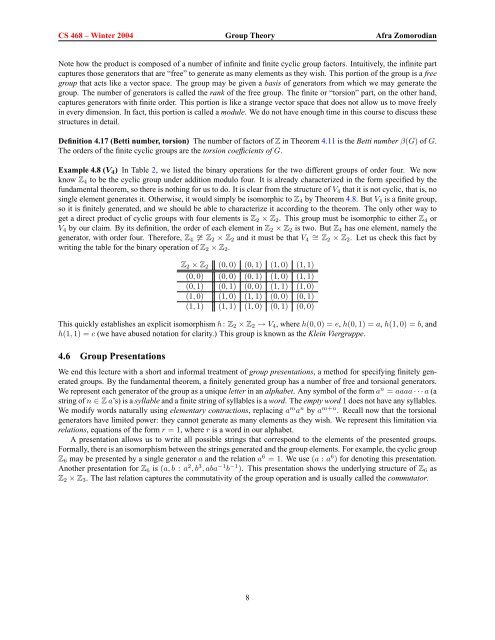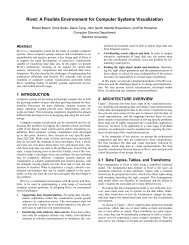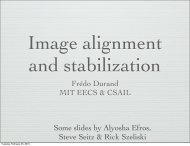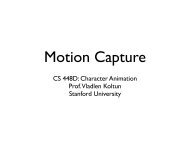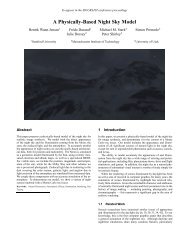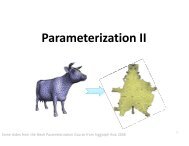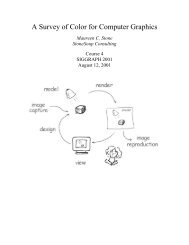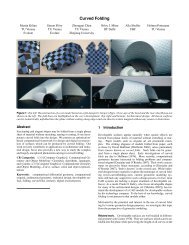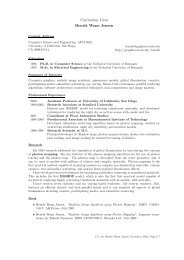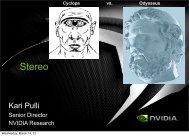Topology for Computing Mini-Kurse pdfsubject - Computer Graphics ...
Topology for Computing Mini-Kurse pdfsubject - Computer Graphics ...
Topology for Computing Mini-Kurse pdfsubject - Computer Graphics ...
Create successful ePaper yourself
Turn your PDF publications into a flip-book with our unique Google optimized e-Paper software.
CS 468 – Winter 2004 Group Theory Afra Zomorodian<br />
Note how the product is composed of a number of infinite and finite cyclic group factors. Intuitively, the infinite part<br />
captures those generators that are “free” to generate as many elements as they wish. This portion of the group is a free<br />
group that acts like a vector space. The group may be given a basis of generators from which we may generate the<br />
group. The number of generators is called the rank of the free group. The finite or “torsion” part, on the other hand,<br />
captures generators with finite order. This portion is like a strange vector space that does not allow us to move freely<br />
in every dimension. In fact, this portion is called a module. We do not have enough time in this course to discuss these<br />
structures in detail.<br />
Definition 4.17 (Betti number, torsion) The number of factors of Z in Theorem 4.11 is the Betti number β(G) of G.<br />
The orders of the finite cyclic groups are the torsion coefficients of G.<br />
Example 4.8 (V4) In Table 2, we listed the binary operations <strong>for</strong> the two different groups of order four. We now<br />
know Z4 to be the cyclic group under addition modulo four. It is already characterized in the <strong>for</strong>m specified by the<br />
fundamental theorem, so there is nothing <strong>for</strong> us to do. It is clear from the structure of V4 that it is not cyclic, that is, no<br />
single element generates it. Otherwise, it would simply be isomorphic to Z4 by Theorem 4.8. But V4 is a finite group,<br />
so it is finitely generated, and we should be able to characterize it according to the theorem. The only other way to<br />
get a direct product of cyclic groups with four elements is Z2 × Z2. This group must be isomorphic to either Z4 or<br />
V4 by our claim. By its definition, the order of each element in Z2 × Z2 is two. But Z4 has one element, namely the<br />
generator, with order four. There<strong>for</strong>e, Z4 � ∼ = Z2 × Z2 and it must be that V4 ∼ = Z2 × Z2. Let us check this fact by<br />
writing the table <strong>for</strong> the binary operation of Z2 × Z2.<br />
Z2 × Z2 (0, 0) (0, 1) (1, 0) (1, 1)<br />
(0, 0) (0, 0) (0, 1) (1, 0) (1, 1)<br />
(0, 1) (0, 1) (0, 0) (1, 1) (1, 0)<br />
(1, 0) (1, 0) (1, 1) (0, 0) (0, 1)<br />
(1, 1) (1, 1) (1, 0) (0, 1) (0, 0)<br />
This quickly establishes an explicit isomorphism h: Z2 × Z2 → V4, where h(0, 0) = e, h(0, 1) = a, h(1, 0) = b, and<br />
h(1, 1) = c (we have abused notation <strong>for</strong> clarity.) This group is known as the Klein Viergruppe.<br />
4.6 Group Presentations<br />
We end this lecture with a short and in<strong>for</strong>mal treatment of group presentations, a method <strong>for</strong> specifying finitely generated<br />
groups. By the fundamental theorem, a finitely generated group has a number of free and torsional generators.<br />
We represent each generator of the group as a unique letter in an alphabet. Any symbol of the <strong>for</strong>m a n = aaaa · · · a (a<br />
string of n ∈ Z a’s) is a syllable and a finite string of syllables is a word. The empty word 1 does not have any syllables.<br />
We modify words naturally using elementary contractions, replacing a m a n by a m+n . Recall now that the torsional<br />
generators have limited power: they cannot generate as many elements as they wish. We represent this limitation via<br />
relations, equations of the <strong>for</strong>m r = 1, where r is a word in our alphabet.<br />
A presentation allows us to write all possible strings that correspond to the elements of the presented groups.<br />
Formally, there is an isomorphism between the strings generated and the group elements. For example, the cyclic group<br />
Z6 may be presented by a single generator a and the relation a 6 = 1. We use (a : a 6 ) <strong>for</strong> denoting this presentation.<br />
Another presentation <strong>for</strong> Z6 is (a, b : a 2 , b 3 , aba −1 b −1 ). This presentation shows the underlying structure of Z6 as<br />
Z2 × Z3. The last relation captures the commutativity of the group operation and is usually called the commutator.<br />
8


